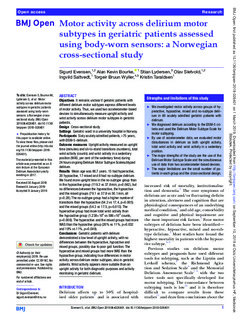| dc.description.abstract | Objectives It remains unclear if geriatric patients with different delirium motor subtypes express different levels of motor activity. Thus, we used two accelerometer-based devices to simultaneously measure upright activity and wrist activity across delirium motor subtypes in geriatric patients.
Design Cross-sectional study.
Settings Geriatric ward in a university hospital in Norway.
Participants Sixty acutely admitted patients, ≥75 years, with DSM-5-delirium.
Outcome measures Upright activity measured as upright time (minutes) and sit-to-stand transitions (numbers), total wrist activity (counts) and wrist activity in a sedentary position (WAS, per cent of the sedentary time) during 24 hours ongoing Delirium Motor Subtype Scalesubtyped delirium.
Results Mean age was 86.7 years. 15 had hyperactive, 20 hypoactive, 17 mixed and 8 had no-subtype delirium. We found more upright time in the no-subtype group than in the hypoactive group (119.3 vs 37.8 min, p=0.042), but no differences between the hyperactive, the hypoactive and the mixed groups (79.1 vs 37.8 vs 50.1 min, all p>0.28). The no-subtype group had a higher number of transitions than the hypoactive (54.3 vs 17.4, p=0.005) and the mixed groups (54.3 vs 17.5, p=0.013). The hyperactive group had more total wrist activity than the hypoactive group (1.238×104 vs 586×104 counts, p=0.009). The hyperactive and the mixed groups had more WAS than the hypoactive group (20% vs 11%, p=0.032 and 19% vs 11%, p=0.049).
Conclusions Geriatric patients with delirium demonstrated a low level of upright activity, with no differences between the hyperactive, hypoactive and mixed groups, possibly due to poor gait function. The hyperactive and mixed groups had more WAS than the hypoactive group, indicating true differences in motor activity across delirium motor subtypes, also in geriatric patients. Wrist activity appears more suitable than an upright activity for both diagnostic purposes and activity monitoring in geriatric delirium. | nb_NO |

